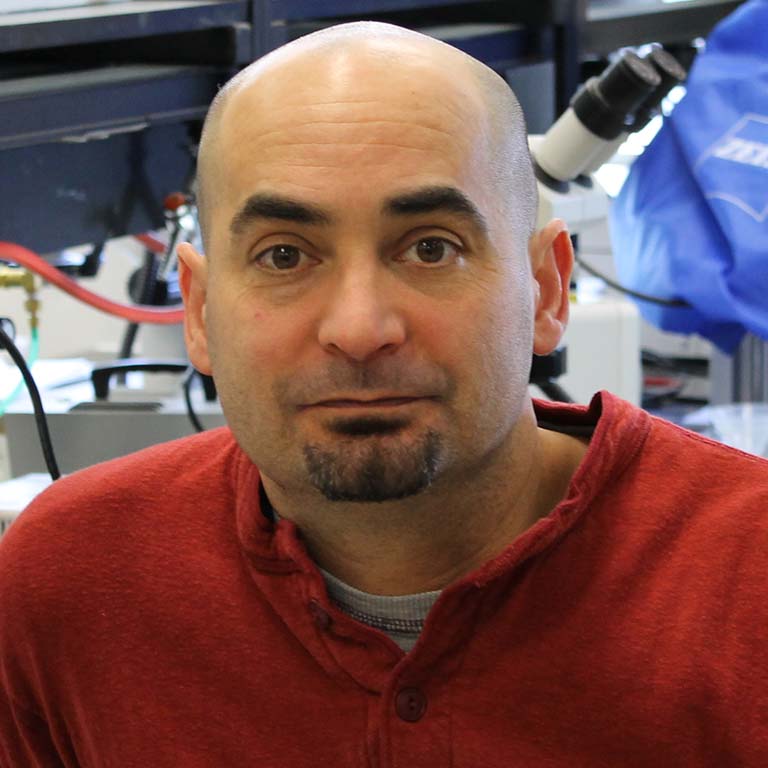Lab
Biology Bldg. 357
812-855-4441
Zelhof Lab website
Research
Photoreceptor cell morphogenesis
An essential feature of photoreceptor cells is the presence of an elaborate membrane structure that houses the millions of receptor proteins required for the detection of light. Whether it is the rhabdomeres of invertebrate photoreceptors, or the membrane discs of vertebrate photoreceptor cells, these sub-cellular compartments are fundamental not only for photon capture, but in addition for the functional integrity of the photoreceptor neuron. Surprisingly, in spite of their importance—and vital roles—in cell biology and sensory physiology, very little is known about the molecular events choreographing the biogenesis and maintenance of rhabdomeres or outer segments discs.
In general, my lab is addressing several questions with respect to photoreceptor cell morphogenesis: What are the molecular mechanisms controlling the initiation of rhabdomere biogenesis and regulating the growth and shaping of the rhabdomeres? What are the cellular mechanisms required for rhabdomere maintenance? Are all rhabdomeres created the same way—what molecular mechanisms exist creating the diversity in rhabdomere structure, organization, and opsin expression? Can rhabdomere morphogenesis serve as a platform to understand human retinal disease? Currently we are focused on the following three areas.
1. Mutational Analysis—Isolating and characterizing genes required for rhabdomere biogenesis. During Drosophila photoreceptor cell development the apical membrane is transformed into a rhabdomere containing thousands of tightly packed microvilli. In order to identify key components of rhabdomere biogenesis, we searched for loci that affect/control the final morphogenetic state of the photoreceptor cell. Our screening strategy was based on the observation that defects in rhabdomere morphology often lead to problems in the arrangement of photoreceptors within the ommatidia, a change that can readily be detected by examining the deep pseudopupil (DPP). Mutations that affect the shape, size or arrangement of the rhabdomeres will result in the absence of a DPP. We now have a library of at least 20 mutations that serves as the molecular basis of the work in the laboratory.
2. Evo-Devo—Defining the transcriptional network required for rhabdomeric photoreceptor cell function and morphogenesis. A comprehensive understanding of eye evolution is no longer limited to morphological comparisons between visual systems but has now advanced to defining the molecular signatures of the different cell types involved each system. With respect to photoreceptor cells, there are two fundamental types, ciliary and rhabdomeric; however, it is not clear how or whether these photoreceptor cell types derived from a single precursor or even more elementary whether there are common genetic and molecular mechanisms within in each cell type defining their form and function. In my lab we are addressing these questions by employing an evolutionary-developmental approach to understand the molecular and cellular mechanisms that regulate and mediate the function (phototransduction) and the form (morphogenesis of the rhabdomere) of rhabdomeric photoreceptor cells. In particular, we are dissecting Pph13 directed regulation of r-opsin expression and rhabdomere morphogenesis in Drosophila and extending our analyses to other key nodal species.
3. Human Disease—Are there common cellular processes for the creation of the two fundamental types of phototransduction compartments, the rhabdomeres and ciliated outer-segments? In Drosophila, the rhabdomere is created by the expansion of the apical surface via the establishment of thousands of microvilli. In cilia-based photoreceptors, the membrane discs are generated via a process of membrane evagination followed by formation of the disk rim around two nascent membrane protrusions creating a single membrane disk. The basis for both structures appears to be a refined sculpting of membrane protrusions. Our work and that of others have identified two key molecules necessary for photoreceptor cell morphogenesis, Prominin/Prominin-1 and Spacemaker/EYS. Using Drosophila as a model system will are determining the physiological role of Prominin and Spacemaker/EYS in photoreceptor cell morphogenesis to better understand the molecular defects seen in Prominin induced human retinal degeneration and arRP25.

 The College of Arts
The College of Arts